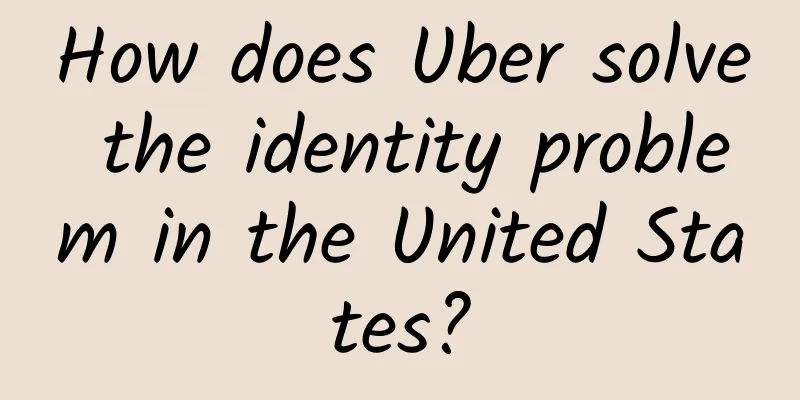How does Uber solve the identity problem in the United States?

|
Today we will not talk about Hangzhou, but how Uber gradually gained legal status in the United States. The United States still faces strong resistance from taxi unions, but some things can be done strategically. We don't want to discuss too much. The following is an old article from Mr. Zhang Yiwen of Fortune Chinese Network. I hope you will not feel "it's useless" after reading it. Imagine a scenario like this: A passenger who has suffered from taxi rejection in Beijing uses a mobile app to find a high-end car on a smoggy day. While he is glad that he can finally return home outside the Fifth Ring Road and enjoy the comfortable seat and clean interior environment of the car, the private car driver, who is dressed in a suit and provides attentive service, is nervously hiding his mobile device equipped with GPS and the same app to prevent the regulator from mistaking it for an illegally operated "black car". The weird thing about this user scenario is that: A demand that is tortured to death by poor services cannot be connected to a more "reasonable" service through "legal" channels. What went wrong? The law, supervision, P2P platforms, or our common sense? This is also the first confusion that people will have when the "private car" special car service is declared illegal today. Looking deeper, is this a kind of joint progress between regulators and disruptive services in the game, or is it a "deterrence" issued by traditional forces - ultimately triggering the "chilling effect" in the field of innovation that we least want to see? The problem of the miserable taxi users is simpler: Can I continue to pay a little more money in the future to hire an obedient driver to go to a place I want to go? Without dwelling on those non-market constraints, by analyzing the game between Uber, Lyft and other companies and regulators in various cities in the United States, the clues to answering the above questions are basically clear. A comprehensive summary is as follows: Identity Game: Who I am determines who controls me Uber was founded in 2009 as "UberCab". In 2011, the company's ride-hailing service was suspended by a large number of American cities. One characteristic of the taxi industry: it is a modern service industry governed by traditional forces that lack innovation; For example, Boston's taxi management department is a "hay carriage" management agency that can be traced back to 1854. This also leads to another characteristic of the industry: its supervision is highly localized. If you want to get rid of supervision, the easiest way is to change your identity: if you say that the son obeys the father's orders, I will sever the father-son relationship with you. Therefore, two years after its establishment, UberCab made a series of countermeasures to avoid legal risks. The most obvious one was to change its name to Uber and remove the word "Cab" from its name. (In fact, an official from a public transportation management department in a certain state in the United States indirectly mentioned that the core of the controversy surrounding the company was originally about the word "Cab".) In this way, the licensed limousines under P2P taxi-hailing should be within the legal scope. They are allowed to be rented, and they are clearly distinguished from taxis through the following three points: 1. No odometer or dome light; 2. Only by appointment; 3. Have a clear itinerary including name and starting point. On the other hand, the remaining private vehicles are still in a gray area. However, the difficulty of supervision by regulators will be greatly increased, because Uber's position in the game has become "my private cars are ordinary city vehicles and are not subject to supervision by taxi management agencies." Case in point: In the fall of 2012, California regulators tried to repeat the old trick and fined Uber and others. This time the startups fought back, and the two sides signed a transition agreement the following year that prevented those restrictive measures from taking effect. Score one for Uber. Understanding this history will help you understand why our current ban starts with "private cars" and why it was initiated from the bottom up by city management agencies. You can also understand why our startups want to distinguish private car services from taxi services. This is equivalent to a safety line in the game. It is foreseeable that if the ban on private cars continues to expand, the special car service will definitely separate the concierge car service from the middle to establish a second line of safety. The game of scale The number of operating licenses is a scarce resource. The scale advantage in the number of taxis is born from the index, which is also a scarce resource, and is monopolized by taxi companies in various cities. For example, the taxi industry in major cities such as Beijing and Shanghai has been frequently criticized for the following problems: on the one hand, the operating profits of taxi management companies are too high, and the profit margins of taxi drivers are too narrow; at the same time, illegal taxis are rampant, and illegal profits are "parasitic" on the fat body of monopoly profits. The ultimate consequence is that people who take taxis and drivers are miserable. The vested interests are unwilling and essentially will not break this window paper. From the perspective of social progress, the existence of this situation is conducive to the entry of entrepreneurs with Internet thinking, the disintermediation of intermediaries, and the breaking of various forms of monopoly or exclusivity. However, there are tens of thousands of taxis in a big city, not to mention the illegal taxis of the same size in China. How can P2P companies gain scale advantage in the business war? At the same time, after facing regulation, the number of private cars in the gray area will gradually decrease, at least those wealthy and wealthy young men will definitely quit. It would be good if the number of cars under P2P does not decrease. In response to such problems, Uber has been exploring potential private car drivers who are willing to endure hardships and creating conditions for them to join the operation. However, such people often do not have cars and even have bad credit. If you dig into CEO Kalanick's history and understand his personality, you will not be surprised by his following countermeasures. To achieve this goal, Uber launched a plan to help these "desperate" drivers connect with a group of even hungrier people - subprime lenders. Their goal is to use subprime loans to allow these carless people to buy vehicles with mortgages, join their own fleets, and form scale advantages; but note that the more important point is that the risks are thrown to financial institutions. As a result of this aggressive strategy, the US federal government began to pay attention to Uber's financial plan, and two of Uber's financial partners, General Motors and Santander Bank's US consumer loan branch, were subpoenaed by the US Department of Justice. However, the "cunning" Uber has remained unscathed so far. Price Game One of the strongest issues that taxi drivers protest against P2P companies is that the latter have flexibility in rates that they cannot obtain. Of course, in the process of disintermediation, this kind of protest is also powerless, because the source of the problem is not the disruptor in front of you, but the intermediary above you. So what are the "intermediaries" doing? We don't know, but in any case, various traditional forces have begun to counterattack in the media - news reports said that a woman was charged $360 (about 2,200 yuan) for a 20-minute Uber ride in Baltimore, and another passenger was charged $539 in Denver, and so on. However, Uber’s response on its official blog is also very Internet-oriented, roughly meaning: The price peak ensures that our service is still available on the night when it is least likely to get a ride. Our prices fluctuate in real time based on supply and demand, and higher prices can encourage more drivers to take to the road to pick up those who are stuck. However, once the peak drops, our app will notify you immediately. Faced with such a response, what can the taxi drivers who start refusing to pick up passengers during peak hours say? And passengers are happy as long as they have the right to choose. Gambling with vested interests The taxi company summarized Uber's major sins through the mouth of the taxi driver: they evaded the license fees, various insurances under regulatory constraints, the flat rates mentioned above, and various other industry regulations. The most core of these is the commercial operating license required by almost all cities. For private cars other than limousines, this problem will always exist, and Uber will always be under the crossfire of all vested interests. Furthermore, if you think the vested interests are only traditional taxi companies, you are wrong. The airports are now more hostile to Uber than the taxi companies. Airports are profit centers for major cities. While taxis and buses rely on airports to make money, the airports also set up detailed rules to obtain their own profits through various fees. This is why when building or renovating airports, designers often leave space to accommodate a large number of taxis and buses. Now that P2P software has become popular, airports have found that their profits are rapidly disappearing. This is why some US international airports may even consider (letting law enforcement agencies) arresting drivers who break the "traditional rules of the game" on the spot. However, if airport owners have a historical perspective, their final choice will definitely not be to eliminate new ride-hailing services, but to try every possible means to summon P2P companies to join their group and deliver benefits to themselves. As to whether the taxis will ultimately incur losses, the airport is essentially unconcerned. Risks from within: the two sides of platform startups Even the most popular companies can be subject to labor laws for being too harsh on their employees. Uber is no exception in this regard. Recently, Uber was accused of using its identity as a "high-tech" company to evasively define its drivers as "(service) contractors." In this way, these platform startups that seem to have the spirit of the Internet actually evade many responsibilities, such as: minimum wage requirements, maximum working hours, drivers are forced to pay for various expenses that should have been paid by the company out of their own pockets... etc. However, these are not harmful to Uber in nature, because these are common labor disputes, and strip bars are occasionally sued for similar reasons. However, there is one thing that is different: vehicle safety insurance. Companies such as Uber and Lyft once vowed to provide their drivers with millions of dollars in compensation plans, etc. However, 14 states immediately reminded the public that passengers may not be covered by the compensation if they encounter a car accident. The reason is simple: because the business model of Uber and other companies determines that drivers are not their employees, the person responsible for the accident is not the company, but the individual driver. On this kind of problem: P2P startups have to deal with it inevitably, otherwise it will become a very obvious competitive disadvantage. Triangle Ending: Entrepreneurs, Users, and Eliminated In summary, we have restored the market environment of a type of startups and compared it with the current domestic situation. The author's attitude is the same as always: instead of providing an answer that is not very meaningful, it is better to provide a method and basis for judgment. Looking at P2P taxi-hailing apps and innovators from the perspective of venture capital, why are investors and entrepreneurs willing to challenge the boundaries of regulation? The answer is simple: once the boundaries of regulation are clear, they may be eliminated, but they also have the same chance to become "champions who get ahead of the game." Then look at the deterrent party, they can't escape the fate of being eliminated in the end. For example, when they first got involved in the music industry, entrepreneurs were always warned: Be careful not to become Napster, or the Chen brothers of Cool Music! Indeed, behind every successful iTunes, there is an unlucky Napster, but more importantly, behind every fallen Napster, there is a group of artists who eventually had to give up the record model and make money by living in the open air and performing in various places. Even if today's "xx taxi" has a certain probability of becoming yesterday's Napster, there is no doubt that today's taxis and companies that provide poor service will almost 100% become "performing artists", or even not qualified to perform. As for users, as long as market competition is allowed (note that this is still a prerequisite), we will always have the opportunity to enjoy first-class services happily. Of course, you will also be the one who pays for this ever-evolving service. As a winner of Toutiao's Qingyun Plan and Baijiahao's Bai+ Plan, the 2019 Baidu Digital Author of the Year, the Baijiahao's Most Popular Author in the Technology Field, the 2019 Sogou Technology and Culture Author, and the 2021 Baijiahao Quarterly Influential Creator, he has won many awards, including the 2013 Sohu Best Industry Media Person, the 2015 China New Media Entrepreneurship Competition Beijing Third Place, the 2015 Guangmang Experience Award, the 2015 China New Media Entrepreneurship Competition Finals Third Place, and the 2018 Baidu Dynamic Annual Powerful Celebrity. |
<<: To Wang Xuehong: The best apology to shareholders is to sell HTC
>>: As the TV drama industry hits its ceiling, will video websites become a lifeline?
Recommend
JingChi Technology and Guangdong Unicom cooperate to build a joint innovation laboratory for L4 autonomous driving 5G
On September 26, autonomous driving startup JingC...
Electric Technology Car News: Changan Oushang vs. Baojun 730: How to choose an independent MPV
In recent years, with the launch of family MPVs b...
How dangerous is asthma? This article answers questions about asthma
If early intervention is carried out on asthma pa...
Lanzhou WeChat mini program distribution function, how much does it cost to develop a mini program distribution system?
Distributing mini programs is the future developm...
What happened to Luckin Coffee’s suspension of trading? What impact will Luckin Coffee’s suspension of trading have?
Since announcing on April 2 that it had falsified...
Apple's Tim Cook: 2015 will be the year of Apple Pay
During Apple's first quarterly conference cal...
Really? The meat we eat in the future may not necessarily come from living animals!
□ Shan Shouqing The steamed buns invented by Zhug...
10 ways to attract new customers and boost your traffic
What I’m going to share today is how to use socia...
How to build a good community using content, users, and activities? (Attached with case)
The article combines the author's actual expe...
Zang Qichao Equity Incentive and Mechanism Design
Zang Qichao's equity incentive and mechanism ...
Want to quickly acquire customers? Here are 2 ways to promote your app to others
In the previous mini program Q&A, we introduc...
As a WeChat operator, you can’t possibly not know these…
"How well do you understand WeChat official ...
Apple iOS 14.5 is officially released. How will App Tracking Transparency affect the advertising world?
In the early morning of April 27, Apple officiall...
GPS has hidden secrets. See how an experienced driver finds the person and the shooting location through a few revealing photos
I sincerely ask everyone to stop asking for seeds!...
Luo Yonghao reviews four flagship phones: Xiaomi's camera is not as good as Huawei's Nut R1, and the overall experience is the best
[Smart Observation Report] In the past two days, ...









